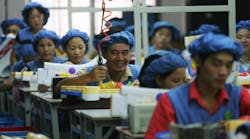PÉKIN, China — A key indicator of China’s manufacturing activity slumped to a 77-month low in August, according to an independent survey released Friday, fueling concerns of further deceleration in the world’s second-largest economy.
The preliminary reading of Caixin’s Purchasing Managers’ Index (PMI) came in at 47.1 this month, the Chinese media group said in a joint statement with Markit, a financial information services provider that compiled the survey.
The figure, which fell from July’s final reading of 47.8, was the worst since a reading of 44.8 in March 2009, according to Markit’s data.
It was also significantly weaker than the median estimate of 48.2 from a poll of economists by Bloomberg News.
The index, which tracks activity in factories and workshops, is seen as a key barometer of the country’s economic health. A figure above 50 signals growth, while anything below indicates contraction.
The figures sent Chinese and regional stock markets lower on concerns about the economy, a key driver of world growth. Shanghai stocks — which have been extremely volatile in recent months — extended falls after the figures came out, closing down 4.27%.
Caixin took over sponsorship of the PMI survey from British banking giant HSBC last month.
“There is still pressure on the front of maintaining growth rates,” He Fan, an economist at Caixin Insight Group, said in the statement. “To realize the goal set for this year, the government needs to fine tune fiscal and monetary policies to ensure macroeconomic stability and speed up the structural reform.”
Beijing set the annual target for economic growth earlier this year at “around 7%.”
China’s economy, a key driver of global growth, expanded 7.4% last year, its weakest since 1990, and has slowed further this year, growing 7.0% in each of the first two quarters.
Nomura economists said Friday’s PMI data suggested growth momentum had weakened in the July-September period.
“We expect monetary policy easing to continue,” they said in a note.
Authorities accept the need to steer China’s growth lower to make it more sustainable and driven by consumer demand rather than investment, but have taken stimulatory measures to put a floor under the slowdown.
The Impact of the Tianjin Blast
Julian Evans-Pritchard, an analyst with research firm Capital Economics, blamed the disappointing August PMI reading on last week’s massive explosions in the northern port city of Tianjin, which killed at least 114 people and caused more than a $1 billion in financial losses.
Another factor was a string of factory closures in Beijing and surrounding areas to ensure blue skies for a large military parade next month to commemorate victory over Japan in World War, he said in a report.
“We still think the downside risks to short-run growth are now overstated,” he said, adding the government “has plenty of policy ammunition” and will not allow growth to slip much further.
In a bid to boost activity, the central bank has cut interest rates four times since November and has also lowered the reserve requirement ratio — the amount of money banks must put aside — three times. It said Wednesday that it has also made $17 billion available to 14 financial institutions to maintain liquidity in the banking system to support growth.
But the People’s Bank of China’s sudden devaluation of the yuan, which fell nearly 5% over a three-day period last week, has raised concerns that China’s economy is growing more slowly than thought.
The bank said the cut was part of reforms to make the exchange rate system more market-oriented, although it was widely seen as a move to help stimulate stalling exports by making them more competitive.
The PMI sub-index for new export orders decreased at a faster pace in August, indicating the impact of the yuan’s falls had yet to kick in.
“The positive effect of RMB depreciation on exports will more likely to be felt in (the) next year,” Nomura analysts said.
Copyright Agence France-Presse, 2015



